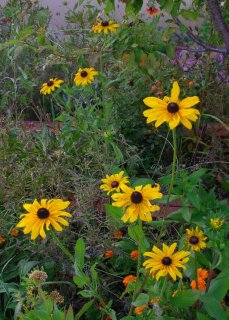 What’s blooming in the area: Roses; chamisa darker; scattered native and Maximilian sunflowers in town. Red peppers and flat, green squash visible with leaves gone.
What’s blooming in the area: Roses; chamisa darker; scattered native and Maximilian sunflowers in town. Red peppers and flat, green squash visible with leaves gone.What’s blooming in my garden, looking north: Black-eyed Susan, blanket flower, chocolate flower, Mexican hat, chrysanthemum.
Looking east: California poppy, winecup, pink bachelor button, larkspur, sweet alyssum; hollyhock back in bloom.
Looking south: Few sensation cosmos near porch.
Looking west: One white phlox (David), Frikarti aster; purple ice plant leaves noraml, but few flowers.
Bedding plants: Petunias, Dalhburg daisies, yellow snapdragons, sweet alyssum.
Animal sightings: Birds in area in morning; gopher set up camp near the peach, both cherries and the new tea roses.
Weather: Rain last Sunday night, cool temperatures Friday morning kill tender annuals before daylight. Zinnias and creeping zinnias gone. Crackerjack marigolds fared better than French; both have flowers on dead stems. Some heavenly blue morning glories, sensation cosmos and sweet peas survive in sheltered areas in village.
Weekly update: Garden writers glorify the fall garden with contrasting foliage and bright berries. In the rio arriba, there is no autumnal drama: everything quietly turns yellow or dies. In my garden, at least, the yellow is concentrated in Black-eyed Susans.
Experts can’t agree if Rudbeckia hirta is an annual, a perennial or a biennial. Unlike tomatoes which follow predictable patterns advertised in numbers of days from sowing to fruit, Black-eyed Susans go through phases that can last for months until conditions trigger the next phase.
Once a seed germinates, the plant produces a basal rosette of leaves. Then, to borrow a farmer’s word, it bolts, puts up a stalk with a single bud. As that flower opens, the plant produces branches and, sometimes, new stems, with more terminal flowers. Finally, it dies.
Catalogs promise bedding plant growers seeds germinate when the soil is 70 degrees, and it takes five to ten days for cotyledons to break the surface. Those who find virtue in the natural, organic life recommend exposing them to cold temperatures first.
Botanists, especially those helping cut flower growers, have determined Rudbeckia hirta needs four days with at least twelve hours of daylight to bolt. Harkess and Lyons found at least twelve such days are needed before the plant can continue flower development with shorter days. Deal and Hartley discovered some cultivars require even longer periods of daylight, and that Toto Gold takes nine weeks to bloom from elongation while Prairie Sun takes eleven. If the plants don’t get enough daylight, they remain rosettes and act as biennials, opening when they finally do get light the following year.
My first flower with narrow, separated petals opened the end of June, probably after the bare minimum number of long days. Most likely, it volunteered from last year. My large, overlapping petaled flowers started blooming the first of August, three months after an April 19 sowing. New stalks, branches and flowers emerged through September from seeds sown May 14 that settled between existing plants.
Conventional wisdom says the composites die after they’ve produced seed. Jamie Whitten tells wildflower growers Black-eyed Susans begin producing when they turn dark gray, about a month after they flower, and the black skinny achenes can be gathered easily when the cones are gray and loose.
Rudbeckia hirta is not self-fertile, and needs another plant to pollinate it. Apparently, they aren’t fussy, and not only mix with other cultivars, but other species to produce variants. In some areas, these strains have survived long enough to stabilize as regional subspecies. No doubt, this is what allows some to behave as perennials.
In my north-facing garden, Black-eyed Susans are decidedly annuals that don’t colonize. By the time they’re able to reproduce, the cold has driven away the necessary insects and there’s not a month left for maturation. Nature may not have intended them to bloom the first year on the northern prairies where days are shorter, but when they are transferred to the high steppes of New Mexico seeds germinate early and meristems absorb enough light to produce one of the last vital flowers of fall.
Notes:
Deal, Tyson and David Hartley. "Flowering of Gloriosa Daisy," research report from W. D. Holley Floriculture Research Program, available on-line.
Harkess, Richard L. and Robert E. Lyons. "Floral Initiation in Rudbeckia hirta (Asteraceae) Under Limited Inductive Photoperiodic Treatments," American Journal of Botany 81:1021-1026:1994.
Whitten, Jamie L. "Black-eyed Susan. " United States Department of Agriculture, 1997, available on-line.
No comments:
Post a Comment